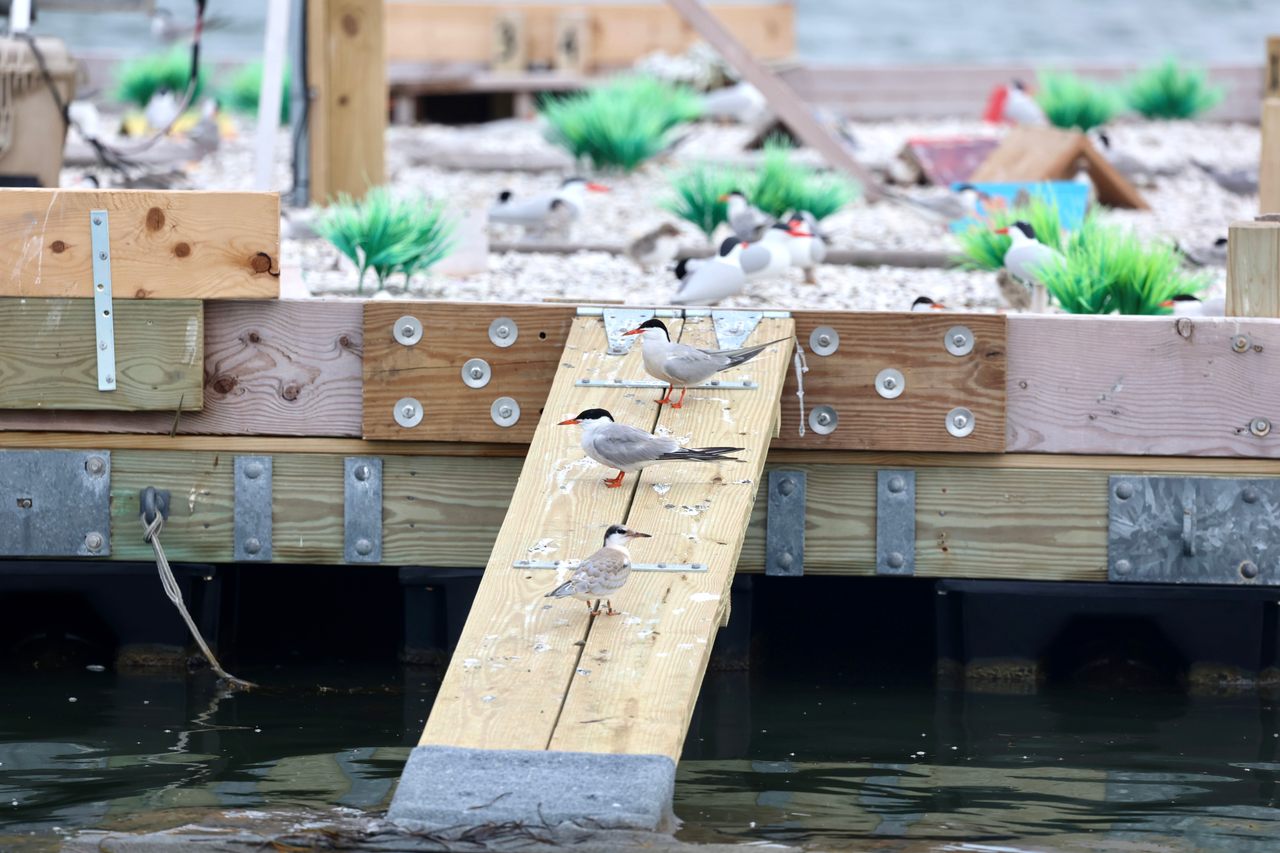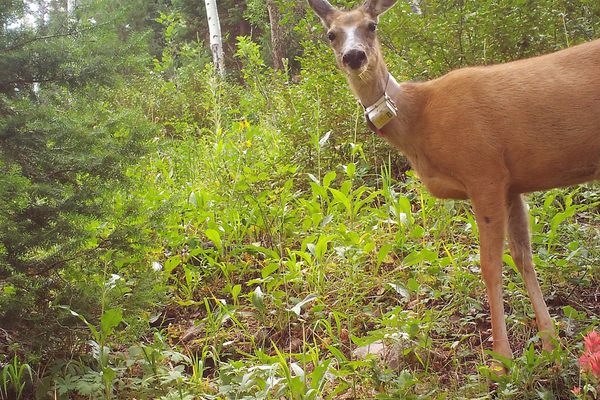Maryland’s Rare Seabirds Get a Life Raft and Babysitters
Scientists don bike helmets and dodge bird poop to care for a colony of endangered common terns.
OH1, a crow-sized seabird with tapered wings, a solid black cap, and beak the color of a traffic cone, touched down just off the Maryland coast on April 18, completing a 3,000-mile migration from Argentina. The common tern was the first summer resident to arrive at a seasonal colony, and the scientists monitoring the site celebrated. Soon, more terns joined OH1, and nesting season was officially underway.
Then, within days, uninvited guests started showing up. Young gulls of different species began to loiter in the area, “just looking for a place to hang out,” says biologist Archer Larned, coastal bird habitat coordinator at the Maryland Coastal Bays Program (MCBP). Eventually, more than 100 of the noisy, pushy teenagers threatened to transform the terns’ breeding colony into their own summer crash pad.
Normally, scientists wouldn’t intervene in this kind of avian real estate dispute, but this wasn’t just any tern colony: Common terns are listed as endangered in Maryland, and this was one of the birds’ last toeholds in the state. This particular colony also happens to be on an artificial wooden raft that’s about the size of a tennis court.

Every spring for the last three years, staff at the MCBP, Audubon MidAtlantic, and the Maryland Department of Natural Resources (DNR) have towed the nesting raft into the brackish blue water of Chincoteague Bay, a narrow slice of ocean situated between the state’s mainland and a chain of barrier islands. The bay was once rich with the kind of nesting habitat colonial seabirds need: small sandy islands where predators are scarce and tufts of vegetation provide shade to flightless chicks on hot summer days. But over the last century, thanks to coastal development and sea level rise, those islands have vanished. As the islands disappeared, so did the terns. By 2020, there were only 60 nesting pairs left.
Initially intended as a temporary solution until something more permanent could be implemented, the rafts have not only stopped the common tern’s population decline—they’ve reversed it. In 2021, 23 pairs of terns nested on the platform’s crushed clamshells; in 2022, 155 sets of parents fledged 140 chicks. For this upward trend to continue this summer, the unwelcome teenage gulls would have to skedaddle.
So MCBP coastal bird conservation specialist Kim Abplanalp positioned a boat nearby and began babysitting the raft, warning off every teenage gull that tried to land. It took the better part of a day, but by sunset the gulls had been evicted. The terns resumed building their nests.
“You become kind of like a mama tern, worried about so many things: storms, [avian] flu, predators,” says Abplanalp, who has been with the project since its start. “You just want them to succeed.”
Figuring out the formula for the birds’ success has been an ongoing process. Maryland DNR regional ecologist Dave Brinker, who first conceived of the raft after reading about a similar project in a Toronto park, says that observing the birds each year, “helps us get into their mind, which helps us get more terns on the rafts.”

For example, during the first year—in addition to the decoys and vocal lures that acted as bait to would-be nesters—the raft contained only clamshell substrate and some tiny wooden lean-tos intended to provide shade to the baby birds. But the adult terns used the chick shelters like fence lines, outlining their territory. “A natural colony will have grass to provide that natural geographic separation,” Brinker says. “So the next year we added plastic grass to break up the visual landscape.”
Multiple cameras, which transmit images and video via wifi, allow the scientists to monitor the birds’ activities remotely—and to keep an eye on the colony when rough weather moves in. The nesting platform, actually nine individual rafts latched together with flexible joints, has survived Tropical Storm Elsa, which churned through the bay in 2021, and a days-long Nor’easter in 2022. During both storms, the team watched from the mainland until the cameras went out. Brinker remembers going to bed wondering “will the anchors hold; will the waves rip the rafts apart?”
The platform survived, and has kept its feathered seasonal residents safe. But things can get dicey for the scientists that climb aboard, which they do throughout the summer to repair equipment, band chicks, and count nests.
“It’s chaos going onto the raft at peak season,” Larned says. “There are so many chicks running every which way, and the adults are dive-bombing and defecating on us.”
Abplanalp adds: “When people are walking on the raft, all you hear is ‘Ow!’ ‘Ow!’ and ‘Stop it!’”
To protect themselves from increasingly aggressive attacks, the scientists began experimenting with head gear. “I started wearing a baseball hat, then a wide-brimmed sun hat, then added feathers to the sun hat, since terns will strike the highest point on your body,” Larned says.

Abplanalp decided to try a bike helmet, which works for bird strikes but not for the birds’ brashest tactic: hair pulling. Despite all this, the terns continue to charm the scientists who care for them.
“You get to know them, see their relationships, see them be good parents and good problem solvers,” says Abplanalp, who last summer grew especially fond of two chicks that were banded on the same day, “and then became teenagers who always hung out together.”
While the nesting platform has become a literal life raft for the tern population, it remains a temporary solution, one engineered to last only about 10 years. The team hopes ultimately to convince the state to rebuild the lost islands using dredged materials from nearby waterways, a process Brinker says will require time, permits, and a good bit of political will. Until then, expect the dedicated team to continue providing a floating refuge for the endangered terns. Teenage seagulls, on the other hand, can find another place to loaf.





























Follow us on Twitter to get the latest on the world's hidden wonders.
Like us on Facebook to get the latest on the world's hidden wonders.
Follow us on Twitter Like us on Facebook